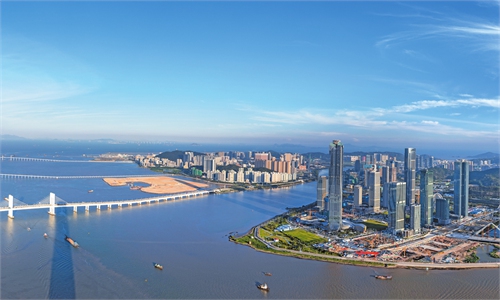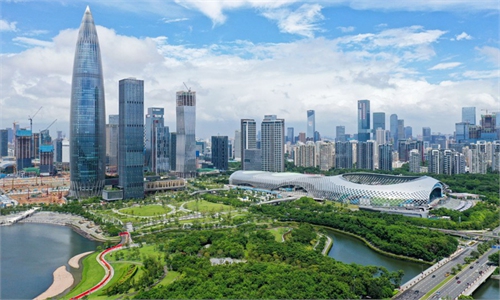IN-DEPTH / IN-DEPTH
Revival of ancient port highlights China's unwavering opening-up
A historical mission
Editor's Note:
Since 2012, China has witnessed an extraordinary economic transition, with historic achievements in all aspects of the economy from its size to quality. Such an unparalleled feat does not just happen, especially during a tumultuous period in the global geo-economic landscape and a tough phase in China's economic transformation and upgrading process. It was Xi Jinping Thought on Socialism with Chinese Characteristics for a New Era that guided the country in overcoming various risks and challenges, and in keeping the China economic miracle alive.
As China embarked on the quest to become a great modern socialist country amid global changes unseen in a century, Xi's economic thought has been and will continue to be the guiding principle for development in China for years to come, and have great significance for the world. What is Xi's economic thought? What does it mean for China and the world? To answer these questions, the Global Times has launched this special coverage on Xi's major economic speeches and policies, and how they are put into practice to boost development in China and around the world.
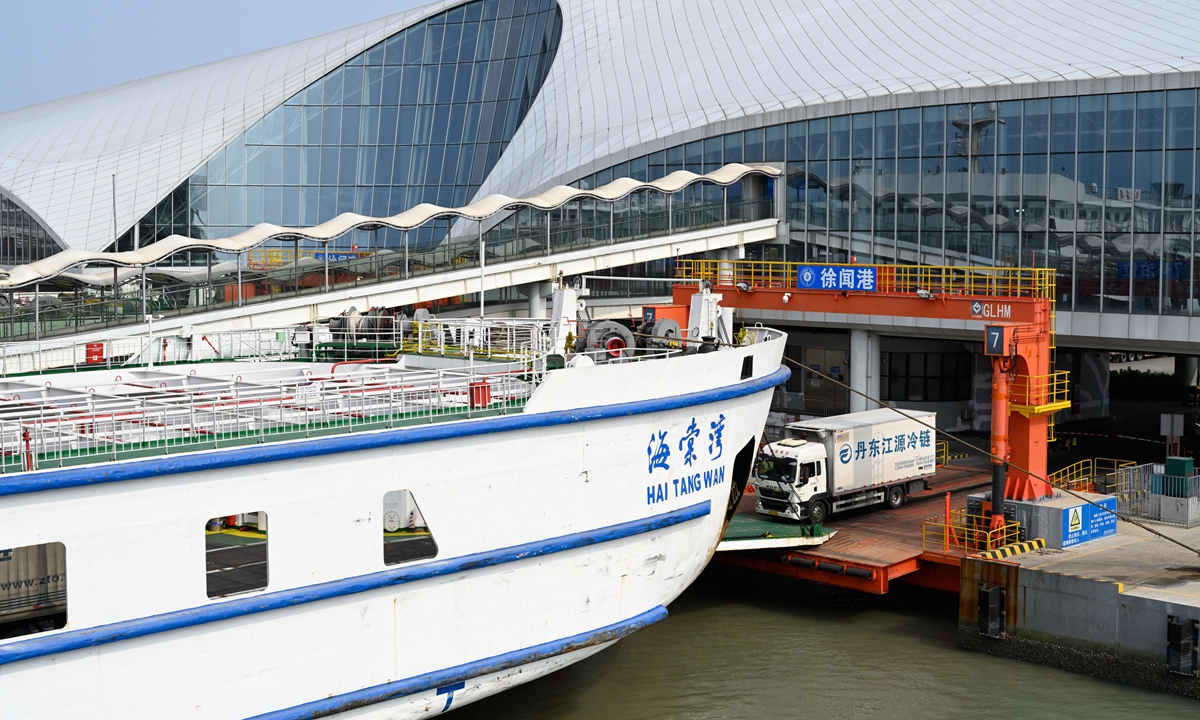
On the afternoon of April 10, Chinese President Xi Jinping, also general secretary of the Communist Party of China Central Committee and chairman of the Central Military Commission, paid a visit to the port, drawing widespread attention to the crucial role the port plays in some of the country's key national development strategies.
Xi stressed that Xuwen Port should be upgraded to a modern, comprehensive hub of water and land transportation that connects the Guangdong-Hong Kong-Macao Greater Bay Area and the Hainan Free Trade Port. He emphasized the role of the Qiongzhou Strait between Guangdong and Hainan as a vital gateway to the development of the Hainan Free Trade Port.
The President's remarks about the crucial position of Xuwen Port as part of key national strategies elevated the sense of responsibility and "glory of the mission" for workers at the port and were a great source of inspiration for them to aim higher, said Zhang Jinhong, chairman of Zhanjiang Xuwen Port Co, noting that following the President's visit, more comprehensive and systemic planning will be carried out to elevate the port's operation, so as to be "truly worthy of our historical positioning."
Xi's inspection of the port that was once crucial for the ancient Maritime Silk Road vividly demonstrates China's unwavering commitment to high-quality opening-up and closer connectivity with the world through the high-quality construction of the Belt and Road Initiative (BRI), which is embodied in Xi's economic thought widely known as "Xiconomics."
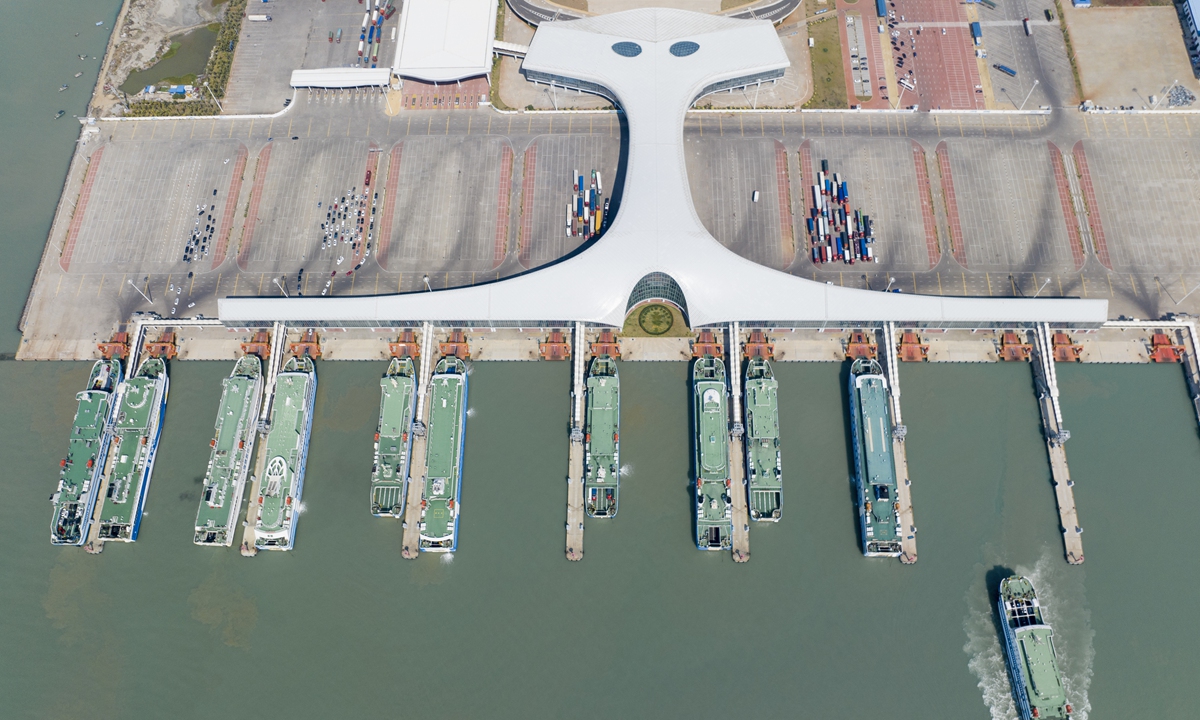
Renewed strategic role
Almost two weeks after Xi's visit to Xuwen Port, Zhang, who accompanied and briefed the president throughout the visit, still recalls every detail and every inquiry vividly. What struck him the most was the renewed strategic role attached to Xuwen Port.
"We have also been thinking about how to improve service quality so that we can develop faster, which is also our goal. But we have never linked our job to the national strategy," Zhang said, noting that the positioning of Xuwen Port as an intersection between the Guangdong-Hong Kong-Macao Greater Bay Area and the Hainan Free Trade Port fosters a sense that "we are shouldering a heavy historical mission and responsibility."
Such a historical mission for Xuwen Port dates back more than 2,000 years ago, when the port was one of the first starting points for the ancient Maritime Silk Road with official record, playing an especially key role in trade with Southeast Asia and South Asia. As early as the Han Dynasty, it had become a crucial trade hub thanks to its unique geographic location. It sits at the southernmost tip of the Chinese mainland and across the Qiongzhou Strait, a crucial transport channel between the mainland and Hainan with the vast South China Sea to its east.
Now, as the country steadily pushes forward with its high-quality opening-up through various major development initiatives, including the BRI and the Hainan Free Trade Port, Xuwen Port's strategic role has consistently been elevated.
During his visit, Xi was informed about Guangdong's endeavors to improve regional connectivity through the development of better transportation infrastructure and the planned alignment of its development with that of the Hainan Free Trade Port. Underscoring the importance he attaches to the port's development, Xi made many detailed inquiries regarding the port's operation, including the design of the main building, operation safety, ferry prices, as well as the food services at the terminal.
"All of what we are doing now has basically met the most basic expectations in terms of connecting the Hainan Free Trade Port and the Guangdong-Hong Kong-Macao Greater Bay Area, though there is still much to improve upon," Zhang said.
To bolster regional infrastructure connectivity, the construction of a modern Xuwen Port started in 2017 with an investment of 2.1 billion yuan ($304.56 million). The port officially started operations in September 2020 and has an annual throughput of about 3.2 million vehicle trips and 17.3 million passenger trips. It cuts down the sea journey to Hainan to 12 nautical miles and the sea crossing time to one hour.
In the first quarter of 2023, Xuwen Port saw a throughput of about 1.57 million vehicle trips, up nearly 52 percent year-on-year, and about 5.29 million passenger trips, up 68 percent year-on-year. The port handles 90 percent of cargo and one-third of total passenger traffic between Guangdong and Hainan.
In fact, to better serve the building of the Hainan Free Trade Port, the port construction, which started in 2017, had to make major adjustments to the design of the port when the master plan for Hainan was announced in 2018.
"We pretty much threw out the original plan and started from scratch," Zhang said, noting that the current plan took into account potential growth in volume brought by the Hainan Free Trade Port.
"Waterfront towers get the moonlight first. We now serve Hainan and the Hainan Free Trade Port, and once the Hainan Free Trade Port is developed, we will enjoy its dividends first," Zhang said, adding that once Hainan begins independent customs, certain logistics capacity can be built in Xuwen.
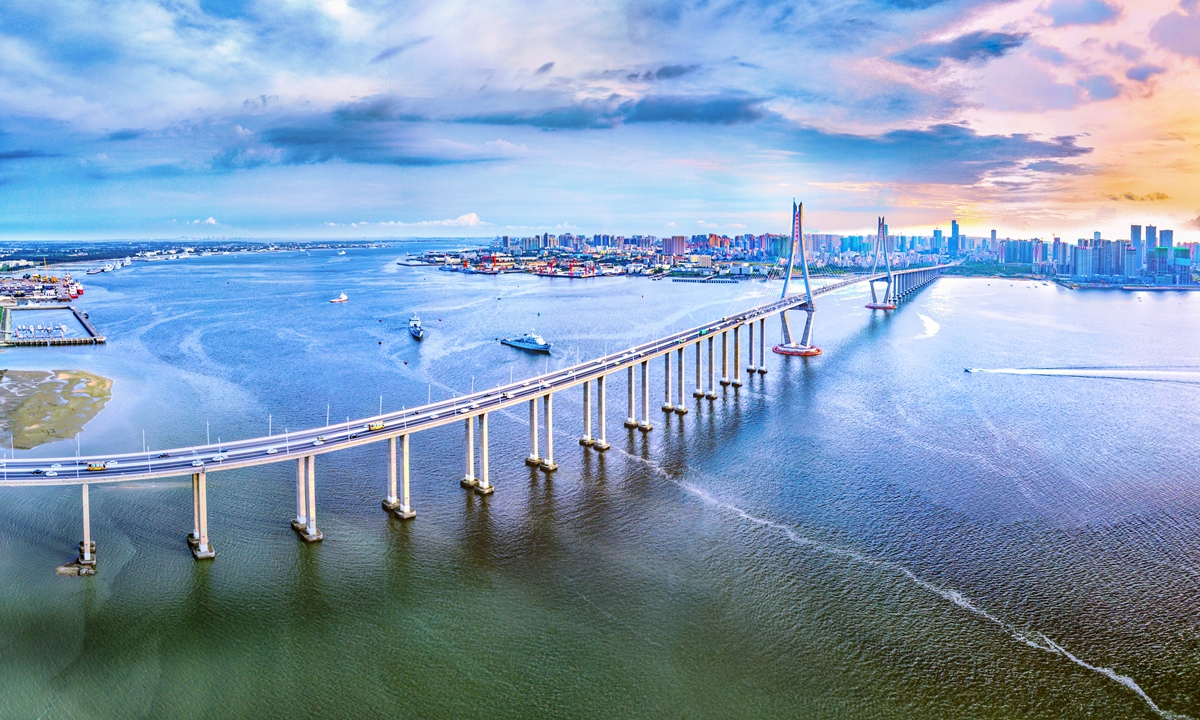
The renewed strategic significance of Xuwen Port is also a direct testament to China's unswerving commitment to high-quality opening-up and high-quality construction of the BRI.
Xi's economic thought also addresses the needs and difficulties of global development through cooperation frameworks such as the BRI. China is also sharing development opportunities with the world through its higher-level opening-up. Many of China's national development strategies highlight this. The Hainan Free Trade Port, which aims to become a top-tier free trade port with global influence by the middle of the century, has epitomized China's resolve to promote high-quality opening-up and opportunities to the rest of the world.
During the inspection tour in Guangdong, the Chinese President also stressed the importance of remaining steadfast in comprehensively deepening reform and expanding high-quality opening-up, and urged Guangdong Province, a pacesetter in the country's reform and opening-up. He expressed hope that foreign investors will seize opportunities and achieve greater business success by coming to China, particularly Guangdong and the Guangdong-Hong Kong-Macao Greater Bay Area. He also stated that China is ready to collaborate with any nations that are interested in engaging in mutually beneficial cooperation to advance the shared prosperity and development of the global economy.
In fact, there are countless real-life examples of China sharing development with the rest of the world. A project delivered by Evergreen in Egypt, based on the mariculture of shrimp and gold pomfret, successfully became a large source of protein for people in Egypt and Evergreen also helped trained over 80 Egyptian experts, creating over 3,000 local jobs in the process, said Chen Dan, chairman of Guangdong Evergreen Group.
Chen also recalled the vivid scenes of the president's visit to a mariculture base under a national-level key project in the city of Zhanjiang, which is run by the company, on April 10. Chen told the Global Times that unlike other companies that impose restrictions on certain exports, Evergreen has been exporting its products and technology to countries along the BRI.
China's continued opening-up has also brought greater opportunities for many overseas traders, including fruit exporters from as far as South America.
Gonzalo Matamala, general manager of Chile-based cherry supplier Giddings Fruit's Asia and China region, said that in recent years he noticed a growing number of new fruit varieties making their way into the Chinese market.
"I think the Chinese government is doing something that is very smart, in that it keeps allowing more fruits from more countries to come into the Chinese market. So, it introduces competition and benefits the Chinese consumer," Matamala said.
Sharing opportunities requires openness and connectivity, which are embodied in China's major development initiatives such as the BRI, and Xuwen Port, which dates back thousands of years, has gained renewed significance. And just like the revival of Xuwen, China is steadily carrying out the historic mission of promoting the high-quality development of the BRI, so as to build greater connectivity that brings greater common development and prosperity. Such a historic mission is palpable in Xuwen.
"We are making a comprehensive and systemic plan and earnestly want to further elevate [the port] to a new stage through years of efforts, so as to be truly worthy of our historical positioning," Zhang said.
Since 2012, China has witnessed an extraordinary economic transition, with historic achievements in all aspects of the economy from its size to quality. Such an unparalleled feat does not just happen, especially during a tumultuous period in the global geo-economic landscape and a tough phase in China's economic transformation and upgrading process. It was Xi Jinping Thought on Socialism with Chinese Characteristics for a New Era that guided the country in overcoming various risks and challenges, and in keeping the China economic miracle alive.
As China embarked on the quest to become a great modern socialist country amid global changes unseen in a century, Xi's economic thought has been and will continue to be the guiding principle for development in China for years to come, and have great significance for the world. What is Xi's economic thought? What does it mean for China and the world? To answer these questions, the Global Times has launched this special coverage on Xi's major economic speeches and policies, and how they are put into practice to boost development in China and around the world.

A cold chain truck enters a cargo ship at Xuwen Port in Zhanjiang, South China's Guangdong Province, on April 24, 2023. Photo: Chen Tao/GT
Sitting at the southernmost tip of the Chinese mainland, Xuwen Port in Zhanjiang, South China's Guangdong Province was one of the starting ports for the ancient Maritime Silk Road more than 2,000 years ago. Today, the port is the world's largest passenger-cargo ro-ro terminal. Despite its crucial historical role, the port had been relatively unknown both at home and abroad - until very recently.On the afternoon of April 10, Chinese President Xi Jinping, also general secretary of the Communist Party of China Central Committee and chairman of the Central Military Commission, paid a visit to the port, drawing widespread attention to the crucial role the port plays in some of the country's key national development strategies.
Xi stressed that Xuwen Port should be upgraded to a modern, comprehensive hub of water and land transportation that connects the Guangdong-Hong Kong-Macao Greater Bay Area and the Hainan Free Trade Port. He emphasized the role of the Qiongzhou Strait between Guangdong and Hainan as a vital gateway to the development of the Hainan Free Trade Port.
The President's remarks about the crucial position of Xuwen Port as part of key national strategies elevated the sense of responsibility and "glory of the mission" for workers at the port and were a great source of inspiration for them to aim higher, said Zhang Jinhong, chairman of Zhanjiang Xuwen Port Co, noting that following the President's visit, more comprehensive and systemic planning will be carried out to elevate the port's operation, so as to be "truly worthy of our historical positioning."
Xi's inspection of the port that was once crucial for the ancient Maritime Silk Road vividly demonstrates China's unwavering commitment to high-quality opening-up and closer connectivity with the world through the high-quality construction of the Belt and Road Initiative (BRI), which is embodied in Xi's economic thought widely known as "Xiconomics."

An aerial view of Xuwen Port in Zhanjiang, Guangdong Province, on February 12, 2023 Photo: IC
Renewed strategic role
Almost two weeks after Xi's visit to Xuwen Port, Zhang, who accompanied and briefed the president throughout the visit, still recalls every detail and every inquiry vividly. What struck him the most was the renewed strategic role attached to Xuwen Port.
"We have also been thinking about how to improve service quality so that we can develop faster, which is also our goal. But we have never linked our job to the national strategy," Zhang said, noting that the positioning of Xuwen Port as an intersection between the Guangdong-Hong Kong-Macao Greater Bay Area and the Hainan Free Trade Port fosters a sense that "we are shouldering a heavy historical mission and responsibility."
Such a historical mission for Xuwen Port dates back more than 2,000 years ago, when the port was one of the first starting points for the ancient Maritime Silk Road with official record, playing an especially key role in trade with Southeast Asia and South Asia. As early as the Han Dynasty, it had become a crucial trade hub thanks to its unique geographic location. It sits at the southernmost tip of the Chinese mainland and across the Qiongzhou Strait, a crucial transport channel between the mainland and Hainan with the vast South China Sea to its east.
Now, as the country steadily pushes forward with its high-quality opening-up through various major development initiatives, including the BRI and the Hainan Free Trade Port, Xuwen Port's strategic role has consistently been elevated.
During his visit, Xi was informed about Guangdong's endeavors to improve regional connectivity through the development of better transportation infrastructure and the planned alignment of its development with that of the Hainan Free Trade Port. Underscoring the importance he attaches to the port's development, Xi made many detailed inquiries regarding the port's operation, including the design of the main building, operation safety, ferry prices, as well as the food services at the terminal.
"All of what we are doing now has basically met the most basic expectations in terms of connecting the Hainan Free Trade Port and the Guangdong-Hong Kong-Macao Greater Bay Area, though there is still much to improve upon," Zhang said.
To bolster regional infrastructure connectivity, the construction of a modern Xuwen Port started in 2017 with an investment of 2.1 billion yuan ($304.56 million). The port officially started operations in September 2020 and has an annual throughput of about 3.2 million vehicle trips and 17.3 million passenger trips. It cuts down the sea journey to Hainan to 12 nautical miles and the sea crossing time to one hour.
In the first quarter of 2023, Xuwen Port saw a throughput of about 1.57 million vehicle trips, up nearly 52 percent year-on-year, and about 5.29 million passenger trips, up 68 percent year-on-year. The port handles 90 percent of cargo and one-third of total passenger traffic between Guangdong and Hainan.
In fact, to better serve the building of the Hainan Free Trade Port, the port construction, which started in 2017, had to make major adjustments to the design of the port when the master plan for Hainan was announced in 2018.
"We pretty much threw out the original plan and started from scratch," Zhang said, noting that the current plan took into account potential growth in volume brought by the Hainan Free Trade Port.
"Waterfront towers get the moonlight first. We now serve Hainan and the Hainan Free Trade Port, and once the Hainan Free Trade Port is developed, we will enjoy its dividends first," Zhang said, adding that once Hainan begins independent customs, certain logistics capacity can be built in Xuwen.

Zhanjiang Bay Bridge in Zhanjiang, South China's Guangdong Province. Photo: VCG
Unswerving commitmentThe renewed strategic significance of Xuwen Port is also a direct testament to China's unswerving commitment to high-quality opening-up and high-quality construction of the BRI.
Xi's economic thought also addresses the needs and difficulties of global development through cooperation frameworks such as the BRI. China is also sharing development opportunities with the world through its higher-level opening-up. Many of China's national development strategies highlight this. The Hainan Free Trade Port, which aims to become a top-tier free trade port with global influence by the middle of the century, has epitomized China's resolve to promote high-quality opening-up and opportunities to the rest of the world.
During the inspection tour in Guangdong, the Chinese President also stressed the importance of remaining steadfast in comprehensively deepening reform and expanding high-quality opening-up, and urged Guangdong Province, a pacesetter in the country's reform and opening-up. He expressed hope that foreign investors will seize opportunities and achieve greater business success by coming to China, particularly Guangdong and the Guangdong-Hong Kong-Macao Greater Bay Area. He also stated that China is ready to collaborate with any nations that are interested in engaging in mutually beneficial cooperation to advance the shared prosperity and development of the global economy.
In fact, there are countless real-life examples of China sharing development with the rest of the world. A project delivered by Evergreen in Egypt, based on the mariculture of shrimp and gold pomfret, successfully became a large source of protein for people in Egypt and Evergreen also helped trained over 80 Egyptian experts, creating over 3,000 local jobs in the process, said Chen Dan, chairman of Guangdong Evergreen Group.
Chen also recalled the vivid scenes of the president's visit to a mariculture base under a national-level key project in the city of Zhanjiang, which is run by the company, on April 10. Chen told the Global Times that unlike other companies that impose restrictions on certain exports, Evergreen has been exporting its products and technology to countries along the BRI.
China's continued opening-up has also brought greater opportunities for many overseas traders, including fruit exporters from as far as South America.
Gonzalo Matamala, general manager of Chile-based cherry supplier Giddings Fruit's Asia and China region, said that in recent years he noticed a growing number of new fruit varieties making their way into the Chinese market.
"I think the Chinese government is doing something that is very smart, in that it keeps allowing more fruits from more countries to come into the Chinese market. So, it introduces competition and benefits the Chinese consumer," Matamala said.
Sharing opportunities requires openness and connectivity, which are embodied in China's major development initiatives such as the BRI, and Xuwen Port, which dates back thousands of years, has gained renewed significance. And just like the revival of Xuwen, China is steadily carrying out the historic mission of promoting the high-quality development of the BRI, so as to build greater connectivity that brings greater common development and prosperity. Such a historic mission is palpable in Xuwen.
"We are making a comprehensive and systemic plan and earnestly want to further elevate [the port] to a new stage through years of efforts, so as to be truly worthy of our historical positioning," Zhang said.




